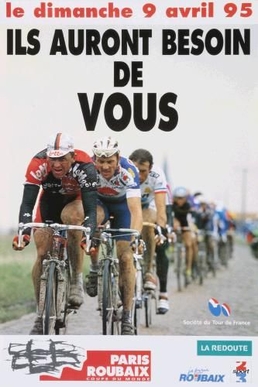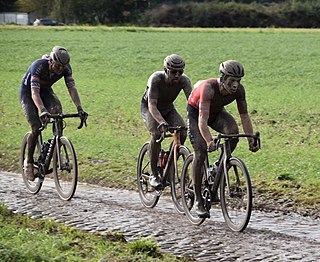
Paris–Roubaix is a one-day professional bicycle road race in northern France, starting north of Paris and finishing in Roubaix, at the border with Belgium. It is one of cycling's oldest races, and is one of the 'Monuments' or classics of the European calendar, and contributes points towards the UCI World Ranking.

Liège–Bastogne–Liège, also known as La Doyenne, is a one-day classic cycling race in Belgium. First run in 1892, it is the oldest of the five Monuments of the European professional road cycling calendar; usually coming as the last of the spring classics. It is held annually in late April, in the Ardennes region of Belgium, from Liège to Bastogne and back.

The classic cycle races are the most prestigious one-day professional road cycling races in the international calendar. Some of these events date back to the 19th century. They are normally held at roughly the same time each year. The five most revered races are often described as the cycling monuments.

La Flèche Wallonne is a men's professional cycle road race held in April each year in Wallonia, Belgium.

A cyclosportive, or often simply sportive, is a short to long distance, organised, mass-participation cycling event, typically held annually. The Italian term Gran Fondo is commonly used for these events in the United States, Australia and some other English-speaking countries.

The Monuments are five classic cycle races generally considered to be the oldest, hardest, longest and most prestigious one-day events in men's road cycling, with distances between 240 and 300 km.

Le Samyn is an annual single-day road bicycle race in Belgium, held usually in late February or early March. The event was created in 1968 as Grand Prix de Fayt-le-Franc, named after the former municipality where it started and finished. In 1970 it was renamed Grand Prix José Samyn as a tribute to José Samyn, the race's first winner who died in a race accident in 1969. Johan Capiot holds the record with three wins.
The 94th running of the Paris–Roubaix single-day cycling classic, was held on 14 April 1996. Classics specialist Johan Museeuw won his first Hell of the North classic; his team mates Gianluca Bortolami and Andrea Tafi completed the all-Mapei podium. The race started in Compiègne and finished on the velodrome of Roubaix, covering a distance of 263.5 kilometres. The race served as the third leg of the 1996 UCI World Cup. Propelled by tailwind, the race had the fastest average speed (43.31 km/h) since Paris–Roubaix was moved to the more difficult easterly route in 1968. It was the 100th anniversary edition of Paris–Roubaix.

The 93rd running of the Paris–Roubaix single-day cycling classic, often known as the Hell of the North, was held on 9 April 1995. Italian Franco Ballerini won his first of two victories, finishing two minutes ahead of the pursuing group after a 30 km solo. Andrei Tchmil won the sprint for second place before Johan Museeuw. The race started in Compiègne and finished on the velodrome of Roubaix, overing a distance of 266.5 kilometres. The race served as the third leg of the 1995 UCI World Cup. 91 of 178 riders finished.

Roger Decock was a Belgian professional road bicycle racer.
The cobbled classics are four cycling classics held in March and April. Cobblestones, like mountainous terrain, are important elements in courses of cycling. Many classic cycle races in northwestern Europe contain cobbled sections. The two Monuments of this race type are the Tour of Flanders and Paris–Roubaix, with over 20 cobbled sectors.
The first edition of Paris–Roubaix, a classic one-day cycle race in France, was held on 19 April 1896. The event covered 280 km (174 mi) from Paris to the velodrome in Roubaix. The winner was German Josef Fischer who received 1.000 francs for the win, a considerable sum of money at the time. The race, as were all editions until 1909, was motorpaced.
Paris–Roubaix Espoirs is a one-day road cycling race held annually in France. In 2005 the race was integrated into the UCI Europe Tour as a category 1.2U race.

Barry-Roubaix is a classic-style road/off-road cycling race featuring a variety of terrain and surfaces to test cyclists of all skill levels. Named to the Global Cycling Network's Top Five Gravel Events and Nine Coolest Races of 2018, the event is known as the World's Largest Gravel Road Race.
The 2011 season for Team Katusha began in January at the Tour Down Under and ended in October at the Giro di Lombardia. As a UCI ProTeam, they were automatically invited and obligated to send a squad to every event in the UCI World Tour.
Paris–Roubaix Juniors is a single-day road bicycle race held annually in April in northern France for junior cyclists ahead of the senior Paris–Roubaix classic race. It is organised by the Vélo-Club de Roubaix Lille Métropole, who organize the under-23s version, Paris–Roubaix Espoirs.

The 1910 Paris–Roubaix was the 15th edition of the Paris–Roubaix, a classic one-day cycle race in France. The single day event was held on 27 March 1910 and stretched 266 km (165 mi) from Paris to its end in a velodrome in Roubaix. The winner of this race for professionals was Octave Lapize from France.

Paris–Roubaix Femmes is a one day women's bicycle race on cobbled roads in northern France, held annually in early April. It is part of the UCI Women's World Tour. The equivalent men's race is a cycling monument, and after the Tour of Flanders and Liège–Bastogne–Liège, is the third to stage a women's edition.
The 2021 Paris–Roubaix Femmes was a French road cycling one-day race that took place on 2 October 2021. It was the first edition of Paris–Roubaix Femmes and the 16th event of the 2021 UCI Women's World Tour. The race was won by Lizzie Deignan of Great Britain, who attacked solo at the beginning of the first cobbled section, with more than two thirds of the course remaining. The winning move went so early, live pictures had not yet begun to be broadcast. Already an historic event as the inaugural women's Roubaix, Deignan's solo victory was later described by commentators as one of the greatest Roubaix rides, male or female, of all time. With the victory, Deignan became the first rider to win all three women's monuments - Paris-Roubaix Femmes, Women's Tour of Flanders and Liège–Bastogne–Liège Femmes.

The 2021 Paris–Roubaix was a road cycling one-day race that took place on 3 October 2021 in France. It was the 118th edition of Paris–Roubaix and the 28th event of the 2021 UCI World Tour. The race was won by Italian Sonny Colbrelli in a sprint finish.












